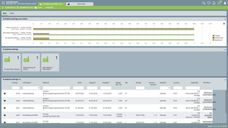Varian, Inc. Advances State-Of-The-Art in Thermal Melts for Studying DNA and Proteins
Advertisement
Palo Alto -September 4- Varian, Inc. (Nasdaq:VARI) announced today the fluorescence BioMelt™ system, a turnkey, application-specific package for studying the thermal characteristics of DNA and proteins. Several unprecedented innovations in the system's sample handling and software significantly advance the speed and accuracy of thermal melt applications. The first of its kind in the world, Varian's unique multi-cell peltier accessory provides the unparalleled temperature accuracy and precision required for measuring multiple samples, and the company's dedicated software allows higher throughput, unmatched measurement accuracy, and excellent repeatability for studies in genomics and molecular biology research.
Fluorescence BioMelt is the latest offering in Varian's BioSolution™ family of products which draw on Varian's core competencies to quickly and effectively create new and better tools for molecular biologists who want complete application specific solutions. Other BioSolutions include the Helix™ system for determining variations in DNA sequence and the TOP™ 96-well plate product for simple, cost-effective, and high-throughput purification of oligonucleotides.
This BioMelt system combines an ultra-sensitive Varian, Inc. fluorescence spectrophotometer with new dedicated thermal application software, and a unique temperature-controlled multi-cell sample handling accessory featuring electronic heat pumps, or peltiers, that controls temperature accurately and precisely. The easy-to-use and flexible thermal software speeds data collection and provides built-in thermal melt calculations for greatly simplified data analysis. The BioMelt system also increases sample throughput via its multi-wavelength measurement capabilities, allowing multiplexing assays to be performed, hence, dramatically improving laboratory throughput without sacrificing accuracy and reproducibility.
Many life scientists are interested in thermal melt experiments using fluorescence because of its unmatched sensitivity, selectivity and greater throughput, especially when working with small sample quantities, which is often the case with biological or synthesized materials. The thermal melt process involves the repeated denaturing/renaturing of DNA which can then be used to determine amino acid base pairs AT and GC (adenine-thymine and guanine-cytosine) content in double-stranded DNA, an important step when investigating drug-DNA interaction.
Another application of the BioMelt system is the use of Fluorescence Polarization (FP) measurements to investigate how the structural characteristics of proteins change in response to variations in temperature and environment. Information gained through FP can prove invaluable when determining how to bind drug candidates to bio-molecules.
As DNA and most other bio-molecules, such as proteins and peptides, are not intrinsically fluorescent, the use of fluorescent tags as markers is necessary. This adds flexibility to the assay by allowing techniques such as Fluorescence Resonance Energy Transfer (FRET) to be used to obtain a wider range of information.






























































